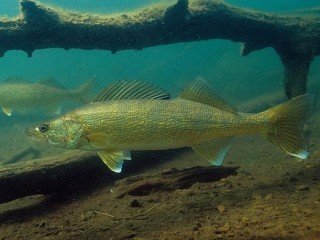 For many anglers, walleye are highly-prized fish known both for colder waters and for amazing tastes when cooked on the grill or in the oven. As one of the most sought-after freshwater species, walleye still remain a mystery to many anglers. Where did walleye get their name? How big can they grow? I’ve never fished for walleye before, what tackle should I use? These are all questions I’ve encountered over the years. I’ve been happy to answer them for each customer I’ve helped in the past and I’m ready to profile such a popular, yet mysterious fish for you all today.
For many anglers, walleye are highly-prized fish known both for colder waters and for amazing tastes when cooked on the grill or in the oven. As one of the most sought-after freshwater species, walleye still remain a mystery to many anglers. Where did walleye get their name? How big can they grow? I’ve never fished for walleye before, what tackle should I use? These are all questions I’ve encountered over the years. I’ve been happy to answer them for each customer I’ve helped in the past and I’m ready to profile such a popular, yet mysterious fish for you all today.
First and foremost, the name: walleye. Where did it come from? Well, from the fish’s eyes, of course. Walleye possess eyes that reflect light and possess special, light-gathering layers that allow them to see exceedingly well in low-light conditions (night, murky and stained waters), which is why you’ll find them in deeper waters. This heightened eyesight gives them an advantage over their prey, as well.
Walleye typically grow to just under three feet and weight around twenty pounds on average, with the largest recorded fish reaching nearly four feet in length and weighing about twenty-five pounds. Most anglers seek walleye that fall within the twelve to twenty inch size range, as fish that size are considered to possess a richer taste.
Fishing for walleye can be done any number of ways. Experienced anglers know that at dawn or duck, or where water is dark or choppy, you’ll be able to find walleye feeding. Casting or trolling spinners or minnow-mimicking baits is popular. Worm harnesses or bottom bouncers are also very effective, traditional methods to entice the deeper fish. When vertical jigging on the bottom, live bait such as worms, leeches, and minnows have proven to be great over the years, as well. In the spring and fall, however, walleye can and will go after other lures as well. Thin-bodied crankbaits such as Cotton
Cordell’s Wally Divers and Rapala’s thin-bodied minnow baits will work well when the bite is active. The best rods to use for walleye will have a lighter tip, to feel the little bites on your lure. XPs makes a Walleye Angler series of rods, and St. Croix’s Eyecon Walleye Rods are great buys if you’re heading to walleye country.
If you’re in the mood for a freezer stocked with great tasting fillets this year, then head to the cooler, northern waters of Canada or the Great Lakes and get into some walleye this season. I suggest chartering a guide if you’ve never fished specifically for walleye before, especially if you’re travelling to walleye waters on a trip. This will ensure that you won’t go home empty-handed. Once you’ve landed your limit, come back to the site and get some great recipes for walleye. Enjoy yourself and dress warm; walleye may enjoy the colder waters, but some fishermen (myself, for example) detest the winter climates, and layers help make the cold days a little more bearable.








